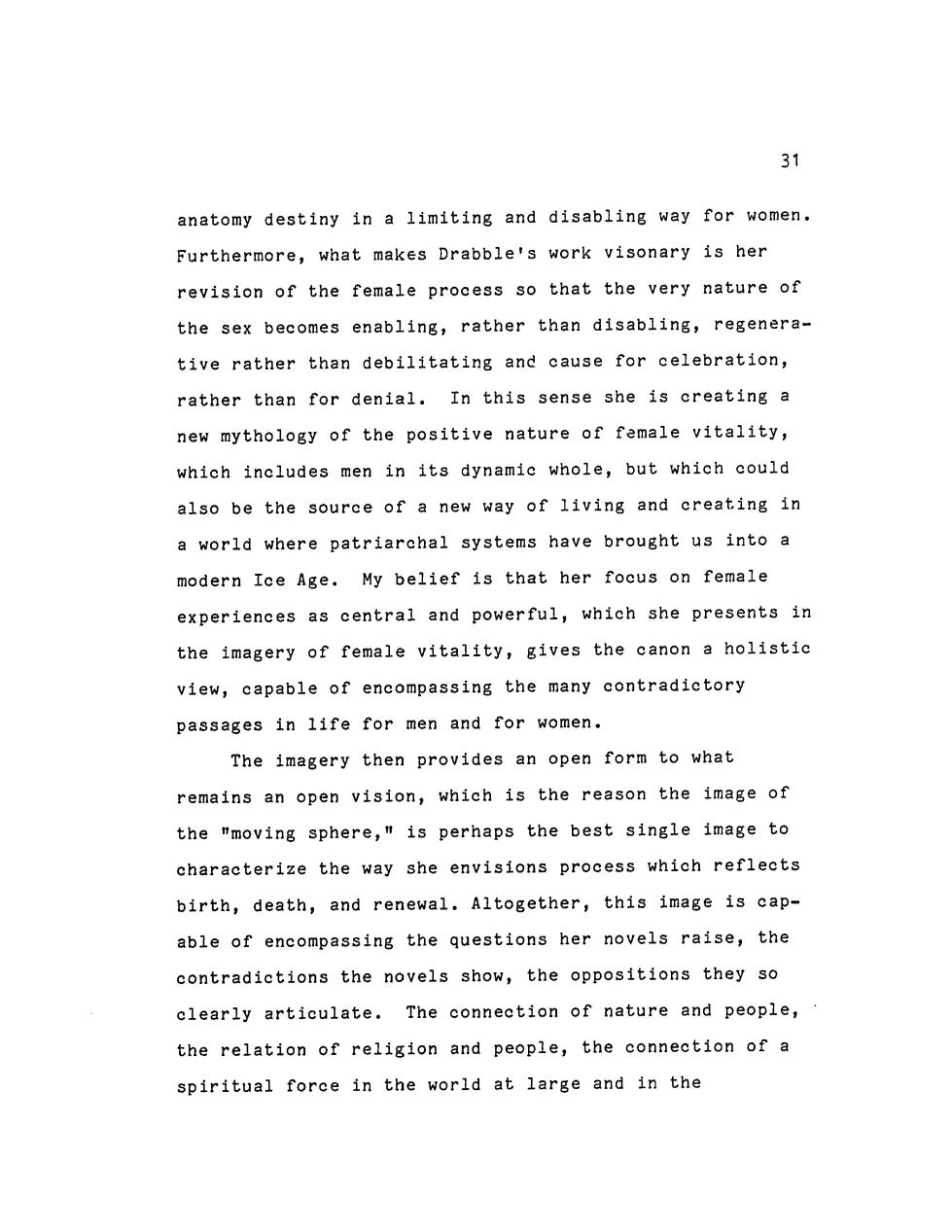
31 anatomy destiny in a limiting and disabling way for women. Furthermore,what makes Drabble's work visonary is her revision of the female process so that the very nature of the sex becomes enabling,rather than disabling,regenera- tive rather than debilitating and cause for celebration, rather than for denial.In this sense she is creating a new mythology of the positive nature of female vitality, which includes men in its dynamic whole,but which could also be the source of a new way of living and creating in a world where patriarchal systems have brought us into a modern Ice Age.My belief is that her focus on female experiences as central and powerful,which she presents in the imagery of female vitality,gives the canon a holistic view,capable of encompassing the many contradictory passages in life for men and for women. The imagery then provides an open form to what remains an open vision,which is the reason the image of the "moving sphere,"is perhaps the best single image to characterize the way she envisions process which reflects birth,death,and renewal.Altogether,this image is cap- able of encompassing the questions her novels raise,the contradictions the novels show,the oppositions they so clearly articulate.The connection of nature and people, the relation of religion and people,the connection of a spiritual force in the world at large and in the
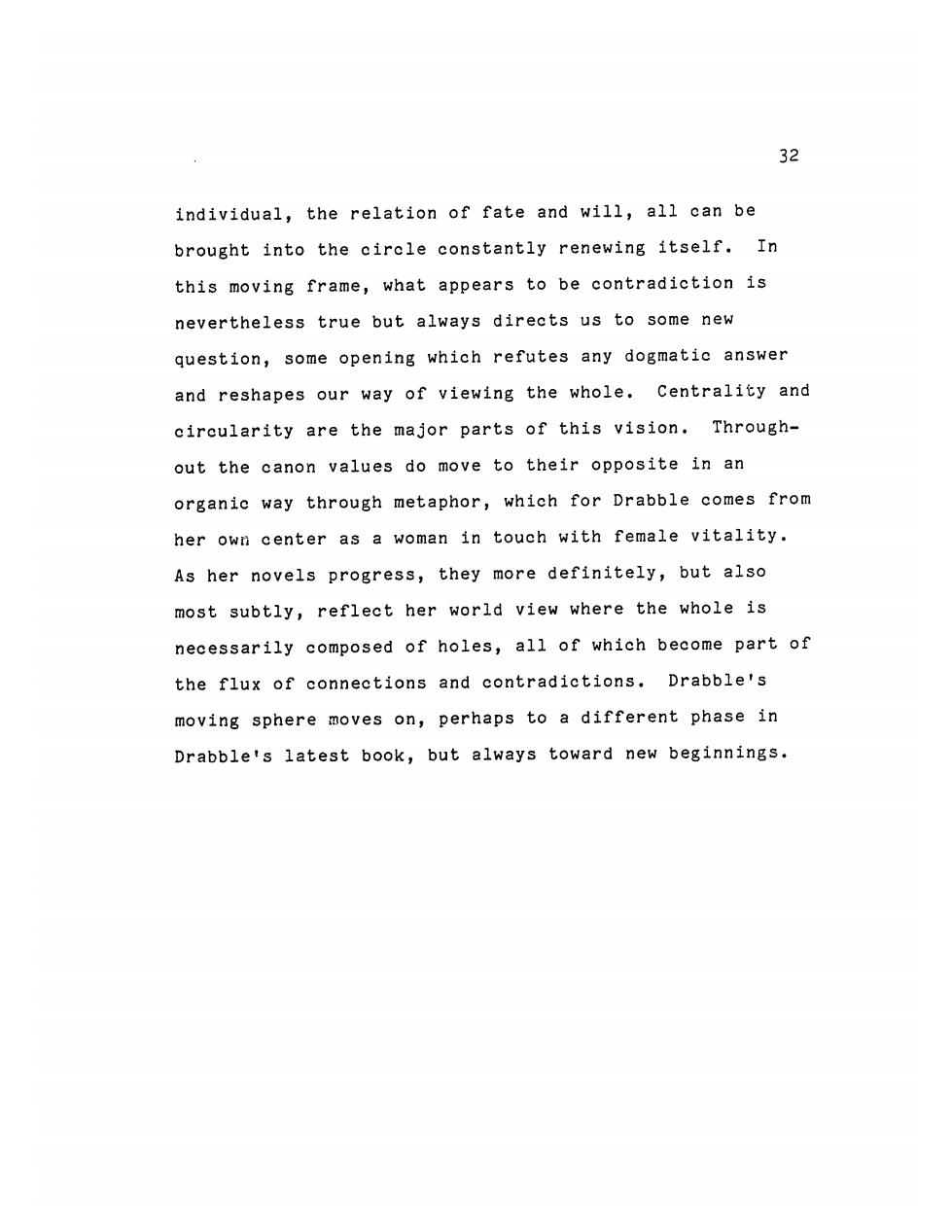
32 individual,the relation of fate and will,all can be brought into the circle constantly renewing itself.In this moving frame,what appears to be contradiction is nevertheless true but always directs us to some new question,some opening which refutes any dogmatic answer and reshapes our way of viewing the whole.Centrality and circularity are the major parts of this vision.Through- out the canon values do move to their opposite in an organic way through metaphor,which for Drabble comes from her own center as a woman in touch with female vitality. As her novels progress,they more definitely,but also most subtly,reflect her world view where the whole is necessarily composed of holes,all of which become part of the flux of connections and contradictions.Drabble's moving sphere moves on,perhaps to a different phase in Drabble's latest book,but always toward new beginnings
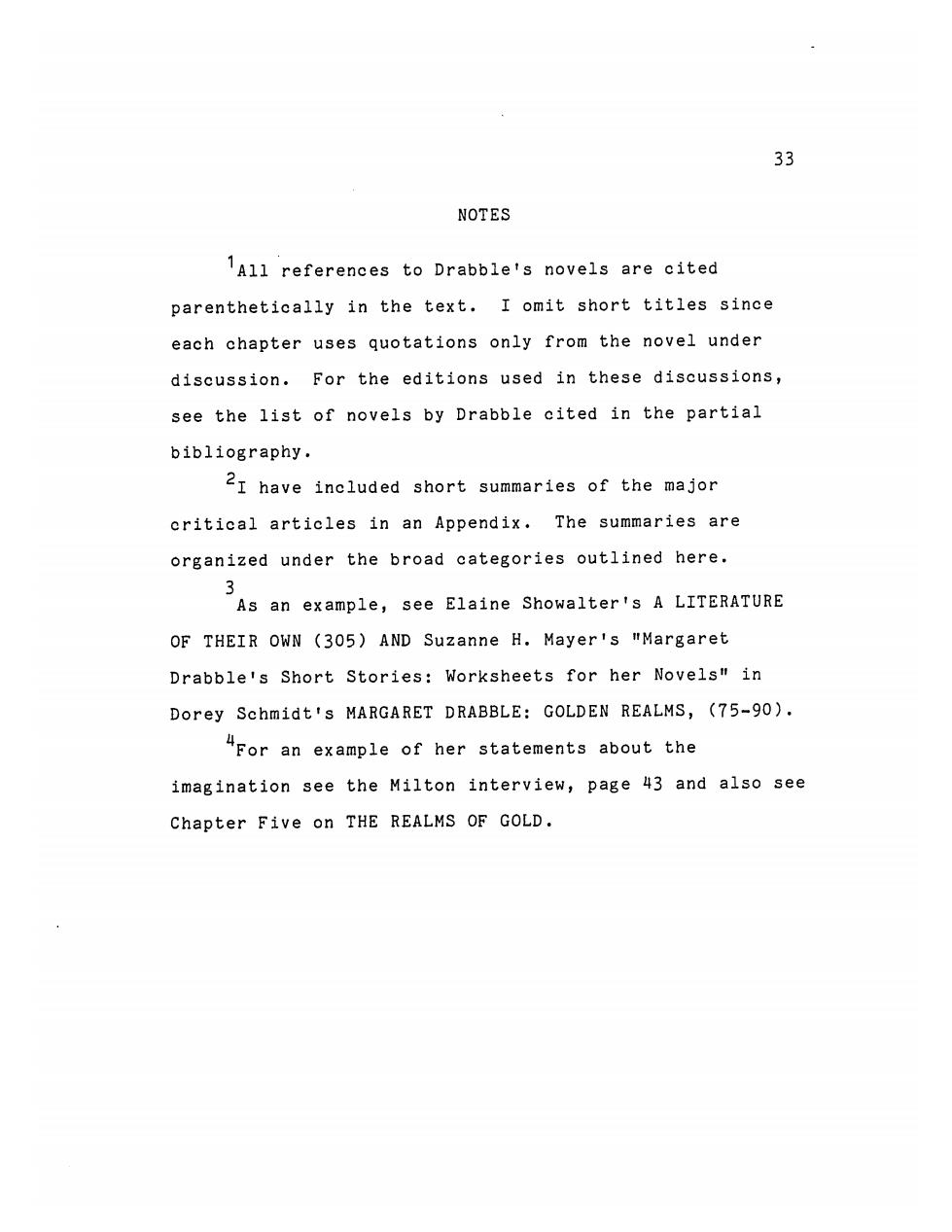
33 NOTES 1All references to Drabble's novels are cited parenthetically in the text.I omit short titles since each chapter uses quotations only from the novel under discussion.For the editions used in these discussions, see the list of novels by Drabble cited in the partial bibliography. 2I have included short summaries of the major critical articles in an Appendix.The summaries are organized under the broad categories outlined here. 3 As an example,see Elaine Showalter's A LITERATURE OF THEIR OWN (305)AND Suzanne H.Mayer's "Margaret Drabble's Short Stories:Worksheets for her Novels"in Dorey Schmidt's MARGARET DRABBLE:GOLDEN REALMS,(75-90). For an example of her statements about the imagination see the Milton interview,page 43 and also see Chapter Five on THE REALMS OF GOLD
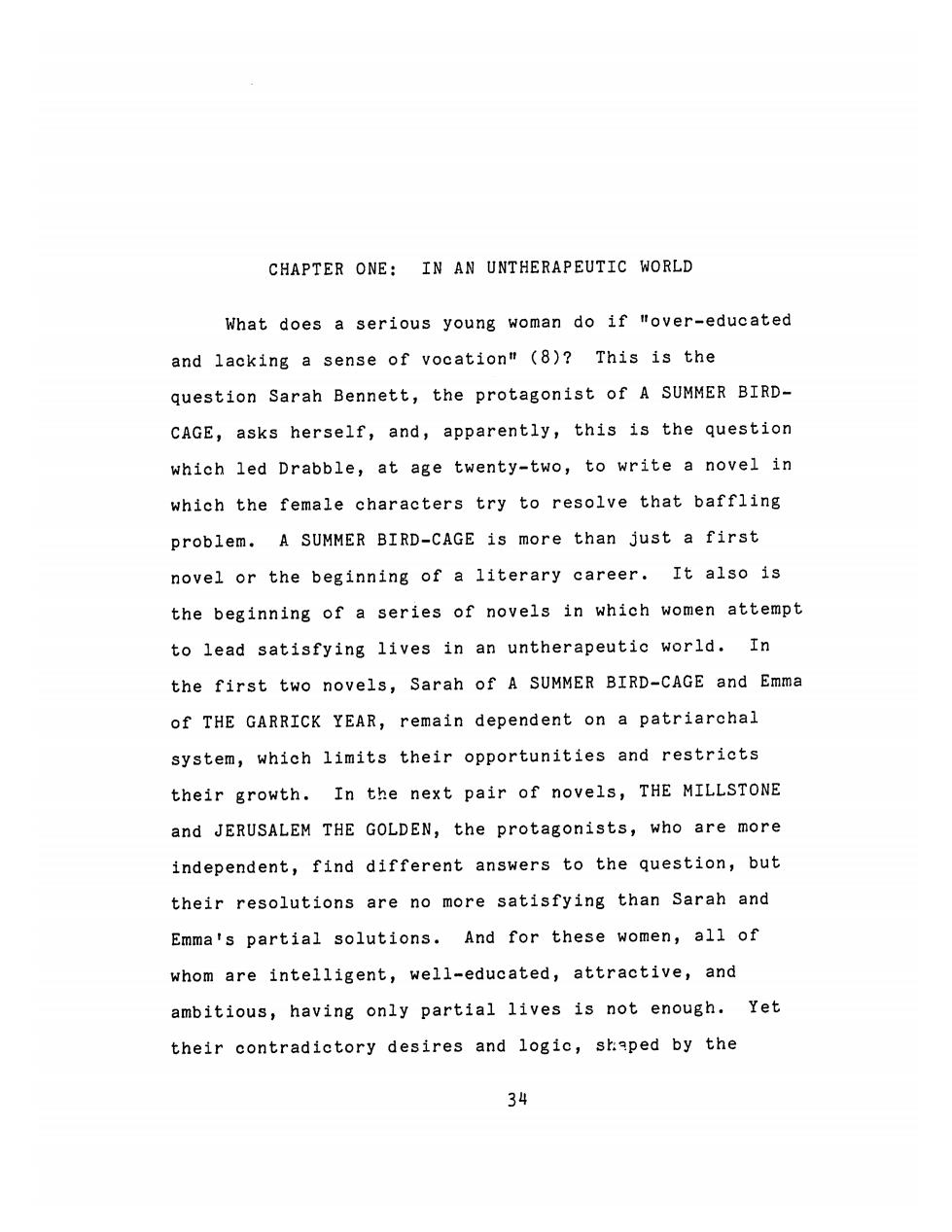
CHAPTER ONE:IN AN UNTHERAPEUTIC WORLD What does a serious young woman do if "over-educated and lacking a sense of vocation"(8)?This is the question Sarah Bennett,the protagonist of A SUMMER BIRD- CAGE,asks herself,and,apparently,this is the question which led Drabble,at age twenty-two,to write a novel in which the female characters try to resolve that baffling problem.A SUMMER BIRD-CAGE is more than just a first novel or the beginning of a literary career.It also is the beginning of a series of novels in which women attempt to lead satisfying lives in an untherapeutic world.In the first two novels,Sarah of A SUMMER BIRD-CAGE and Emma of THE GARRICK YEAR,remain dependent on a patriarchal system,which limits their opportunities and restricts their growth.In the next pair of novels,THE MILLSTONE and JERUSALEM THE GOLDEN,the protagonists,who are more independent,find different answers to the question,but their resolutions are no more satisfying than Sarah and Emma's partial solutions.And for these women,all of whom are intelligent,well-educated,attractive,and ambitious,having only partial lives is not enough.Yet their contradictory desires and logic,shaped by the 34
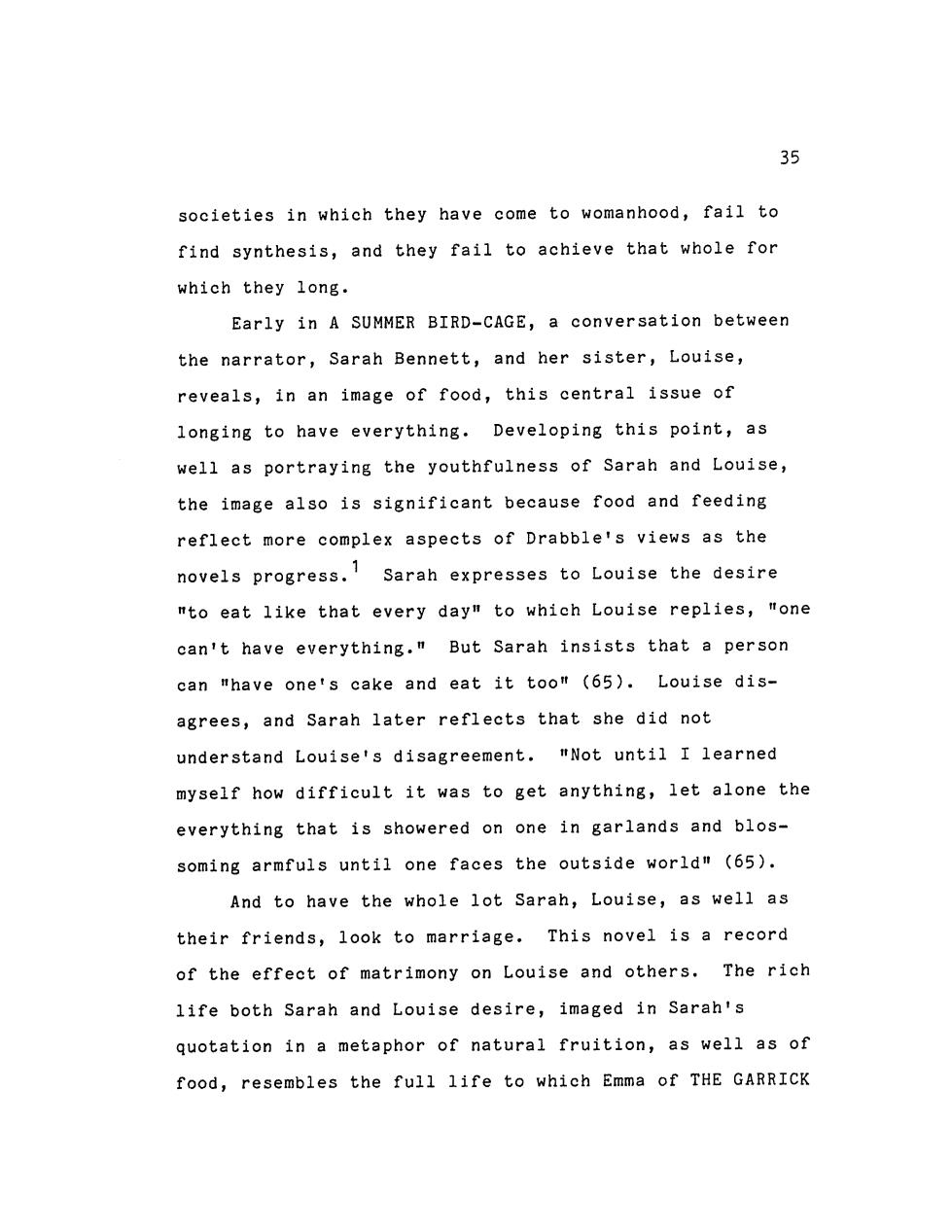
35 societies in which they have come to womanhood,fail to find synthesis,and they fail to achieve that whole for which they long. Early in A SUMMER BIRD-CAGE,a conversation between the narrator,Sarah Bennett,and her sister,Louise, reveals,in an image of food,this central issue of longing to have everything.Developing this point,as well as portraying the youthfulness of Sarah and Louise, the image also is significant because food and feeding reflect more complex aspects of Drabble's views as the novels progress.1 Sarah expresses to Louise the desire mto eat like that every day"to which Louise replies,"one can't have everything."But Sarah insists that a person can "have one's cake and eat it too"(65).Louise dis- agrees,and Sarah later reflects that she did not understand Louise's disagreement."Not until I learned myself how difficult it was to get anything,let alone the everything that is showered on one in garlands and blos- soming armfuls until one faces the outside world"(65). And to have the whole lot Sarah,Louise,as well as their friends,look to marriage.This novel is a record of the effect of matrimony on Louise and others.The rich life both Sarah and Louise desire,imaged in Sarah's quotation in a metaphor of natural fruition,as well as of food,resembles the full life to which Emma of THE GARRICK